
Microhyla sholigari is a species of microhylid frog endemic to southern India. It was described from the Biligirirangan Hills in Chamarajanagar district, Karnataka and is named after the Soliga tribal people living in the forests in and around these hills. The frog was thought to be endemic to the Western Ghats and known only from the type locality and another location in Kerala and was listed as an Endangered species. A recent study reported the species from 15 localities in the central Western Ghats with individuals sighted near the Bannerghatta National Park, Bangalore, Karnataka. The study supplemented the original species description with color photographs, call recordings and provided a re-assessment of the threat status as per the IUCN Red List and suggest the status as Least-concern species because the criteria for classifying it as an endangered species are no longer fulfilled.

Adenomus is a small genus of true toads, with only two species, endemic to Sri Lanka. Adenomus kandianus was considered as extinct for 133 years, but was rediscovered in October 2009 in the Kandy area.

Microhyla, commonly known as the rice frogs or narrow-mouthed frogs, is a genus of frogs in the family Microhylidae. It consists of 42 species of diminutive frogs. Members of this genus are widespread from Ryukyu Is. in Japan, and throughout South-east Asia,.
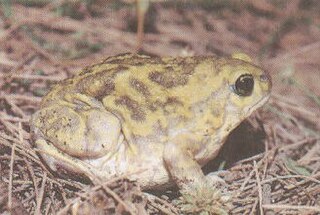
Uperodon is a genus of microhylid frogs. They occur in South Asia and Myanmar. Uperodon reached its current composition in 2016 when the genus Ramanella was brought into its synonymy. The common names of these frogs are globular frogs and balloon frogs in reference to their stout appearance, or dot frogs, the last specifically referring to the former Ramanella.

Microhyla chakrapanii is a species of frog in the family Microhylidae, the narrow-mouthed frogs. It is endemic to the Andaman Islands. It is also known as the Mayabunder rice frog, Chakrapani's narrow-mouthed frog, and bilateral banded frog. Although morphology suggests association with the Microhyla achatina group, molecular data places it in the Microhyla fissipes group, with Microhyla mymensinghensis as its closest relative.
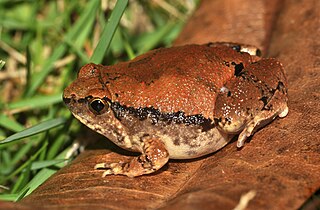
Microhyla rubra is a species of narrow-mouthed frog endemic to India. Earlier thought to exist also in Sri Lanka, new studies suggested that Sri Lankan population is a different species, now elevated to species level as Microhyla mihintalei.

Indosylvirana aurantiaca, commonly known as the golden frog, is a species of frog endemic to the Western Ghats of India. The species is also known as the Trivandrum frog, the common wood frog, or the small wood frog.

Adenomus kandianus is a species of toad in the family Bufonidae endemic to Sri Lanka. It is a high-altitude species known only from few localities. The specific name kandianus means "from Kandy" and seems to suggest that the type material came from near the city of Kandy.
Microhyla borneensis, also known as the Matang narrow-mouthed frog, is a species of microhylid frog found in the Matang Range in Sarawak, Borneo. It was once the smallest known frog from the Old World. Adult males of this species have a snout-vent length (SVL) of 10.6–12.8 mm (0.42–0.50 in), but adult males can reach a maximum of 13 mm (0.51 in),and adult females of this species have a snout-vent length of 16–19 mm (0.63–0.75 in), Tadpoles measure just 3 mm.
Microhyla karunaratnei is a species of frog in the family Microhylidae. It is endemic to southern Sri Lanka. It is also known as the Karunaratne's narrow-mouth frog or Karunaratne's narrow-mouthed frog. The specific name karunaratnei honours G. Punchi Banda Karunaratne, a Sri Lankan naturalist.
Uperodon nagaoi, also known as the Nagao's pug-snout frog or Nagao's globular frog, is a species of frogs in the family Microhylidae. It is endemic to Sri Lanka and is known from the Central, Sabaragamuwa, Southern, and Western Provinces. The specific name nagaoi honours Eijiro Nagao, president of Marusan Securities who, through the Nagao Environmental Foundation, has supported research on Sri Lankan amphibians.
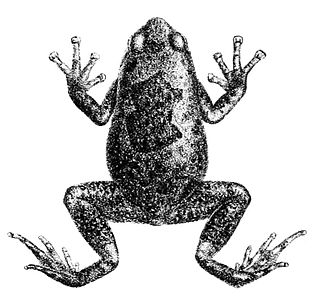
Uperodon obscurus is a species of frog in the family Microhylidae. It is endemic to Sri Lanka. Its natural habitats are subtropical or tropical moist lowland forests, subtropical or tropical moist montane forests, freshwater marshes, intermittent freshwater marshes, rural gardens, and heavily degraded former forest.

Hylarana, commonly known as golden-backed frogs, is a genus of true frogs found in tropical Asia. It was formerly considered highly diverse, containing around 84 to 96 valid species, but taxonomic revision resulted in a major change in the contents of the genus, and today it is recognised as containing just four species.

Indosylvirana sreeni, also known as Sreeni's golden-backed frog, is a species of frog in the family Ranidae found in Southern Western and Eastern Ghats in the states of Kerala and Tamil Nadu, India, at elevations of 100 to 1500 meters.

Indosylvirana indica, the Indian golden-backed frog, is a species of frog in the family Ranidae. It was formerly considered as conspecific with Indosylvirana temporalis but was found to be a distinct species in a 2014 study.
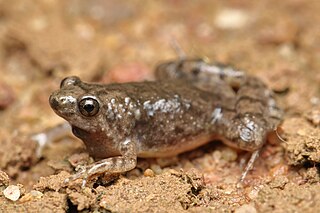
Microhyla kodial, the Mangaluru narrow-mouthed frog, is a frog species belongs to family Microhylidae. It is likely endemic to a small portion of India, and was discovered in the urban part of Mangalore. This new discovery was published at international journal Zootaxa on Tuesday May 16, 2018.

Lankanectes pera is a species of frog in the family Nyctibatrachidae. It is the second species found within the genus Lankanectes. It is endemic to Sri Lanka.
Indosylvirana serendipi, or the Sri Lankan golden-backed frog, is a species of frog in the family Ranidae. It is endemic to Sri Lanka.
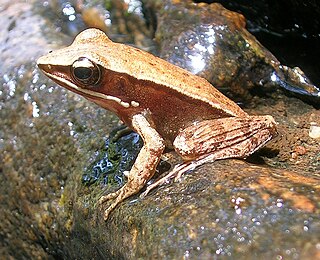
Indosylvirana is a genus of ranid frogs endemic to South and Southeast Asia.
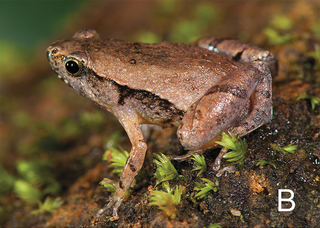
Microhyla darreli is a species of frog in the family Microhylidae, the narrow-mouthed frogs. It is endemic to the Western Ghats south of the Palghat Gap in southern India. It is named for Darrel Frost, an American herpetologist, in recognition of the online database Amphibian Species of the World that he maintains. Accordingly, common name Darrel's chorus frog has been coined for this species.















